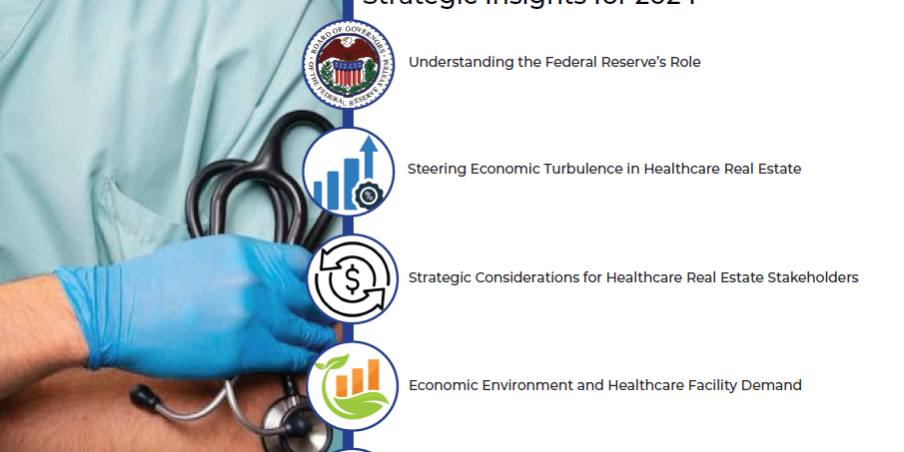The healthcare industry continues to grapple with the ripple effects of economic turbulence. As inflationary pressures persist and the Federal Reserve maintains its assertive monetary policy stance, the real estate landscape for healthcare providers is undergoing a seismic shift. Cost pressures are mounting, and the need for strategic optimization has never been more critical. In this climate of uncertainty, healthcare organizations must adapt swiftly, leveraging the expertise of industry-savvy partners to navigate the intricate challenges that lie ahead.
At the heart of this transformation lies a fundamental shift in the perception of real estate assets. No longer viewed as a mere fixed expense, healthcare real estate has emerged as a strategic asset that can either propel an organization’s growth or impede its progress. Capitalizing on this paradigm shift requires a nuanced understanding of market dynamics, coupled with a proactive approach that anticipates industry trends and positions organizations for long-term success. By embracing innovative strategies and embracing the potential of real estate optimization, healthcare providers can transform economic headwinds into tailwinds that drive operational efficiency, enhance patient experiences, and fortify their competitive edge.
Understanding the Federal Reserve’s Role
The Federal Reserve, often simply referred to as “the Fed,” plays a pivotal role in the economic stability of the United States. It regulates banks, supervises financial institutions, and manages economic fluctuations using tools such as the reserve ratio, interest rates, and open market operations. These tools help control inflation, manage employment levels, and stabilize the financial system. Understanding the pivotal role the Federal Reserve plays in shaping these economic conditions provides the backdrop for navigating the complex healthcare real estate landscape.
Steering Economic Turbulence in Healthcare Real Estate
In particular, interest rates are a powerful mechanism in monetary policy. This recent rise is attributed to prolonged periods of low borrowing costs, extensive economic stimulus measures, and regulatory changes like the Regulation D reserve requirement exemption, all of which have infused the markets with liquidity, heightening inflationary pressures. This interplay between monetary policy and market liquidity sets the stage for healthcare real estate stakeholders to reassess their strategies in response to rising interest rates.
Strategic Considerations for Healthcare Real Estate Stakeholders
Given the current economic signals and the Fed’s indication of continued rate hikes, as stated by Fed Chairman Jerome Powell, healthcare real estate stakeholders must consider several strategic moves:
• Timing the Market: For those considering selling healthcare properties, it may be advantageous to initiate transactions while interest rates still favor high valuations, thereby maintaining buyer interest and aggressive pricing.
• Refinancing: Property owners who have benefited from low interest rates in recent years may find refinancing now less advantageous if it does not significantly reduce monthly payments, given the rising interest rates.
• Long-Term Investments: For investors, the high demand for healthcare real estate, driven by its low-risk profile and stable returns, remains appealing. However, careful analysis of the long-term impact of economic shifts, including potential softening of asset prices, is crucial.
Given these challenges, it is essential for healthcare real estate stakeholders to strategically position themselves to manage and capitalize on the evolving economic landscape.
Economic Environment and Healthcare Facility Demand
The broader economic environment also plays a pivotal role in shaping demand for healthcare facilities. Economic growth leads to higher employment and potentially increased health insurance coverage, driving demand for healthcare services and, subsequently, real estate. However, in times of economic downturn, healthcare providers may see a shift in patient volumes and services, impacting facility needs and investment plans. Beyond internal strategy adjustments, the broader economic environment continues to influence the demand for healthcare facilities, driving the need for adaptive real estate solutions.
Key Trends Influencing Healthcare Real Estate in 2024
These macroeconomic and demand-driven factors converge to highlight several key trends that will define the healthcare industry in the coming year:
1. Strategic Optimization of Real Estate Assets: In light of rising costs, healthcare organizations must look at real estate not just as a fixed expense but as a strategic asset. At RCR, we guide our clients through optimizing their real estate portfolios, ensuring that each property is not only cost-effective but also strategically aligned with their long-term business objectives.
2. Talent Acquisition and Retention: The ongoing shortage of healthcare professionals requires innovative solutions in real estate. By creating environments that enhance employee satisfaction and engagement, we help our clients attract and retain top talent, a crucial factor in maintaining competitive advantage.
3. Consolidation and Efficient Use of Space: With the trend towards consolidation in healthcare, managing real estate efficiently becomes essential. We assist our clients in evaluating their current assets and integrating new properties post-merger, ensuring seamless transitions and optimal space utilization.
4. Embracing Technology in Facility Management: The integration of Artificial Intelligence (AI) and other technologies can transform facility management. At RCR, we are at the forefront of incorporating tech-driven solutions that enhance operational efficiency and patient care in healthcare facilities.
5. Adapting to Consumer-Centric Care Models: As healthcare moves closer to a consumer-centric model, the need for conveniently located and well-designed facilities grows. We help our clients develop real estate strategies that align with this shift, enhancing accessibility and patient experience.
Why RCR is Your Ideal Healthcare Real Estate Partner
Managing these trends requires more than just awareness—they demand proactive, tailored strategies that align with specific organizational goals. This is where RCR distinguishes itself as your ideal healthcare real estate partner. Our approach at RCR goes beyond traditional real estate practices. We understand that in today’s economic climate, healthcare providers require partners who are not only experts in real estate but who also understand the intricacies of the healthcare industry. Here’s how we make a difference:
• Proactive Market Insights: We keep our clients ahead of the curve by providing up-to-date market insights that anticipate shifts in economics and patient demand.
• Customized Real Estate Solutions: Each client’s needs are unique. We tailor our real estate solutions to align with your specific operational and financial objectives.
• Strategic Asset Optimization: Through strategic asset management, we ensure your real estate investments are primed for both current success and future growth.
While the healthcare sector continues to navigate through economic pressures and market transformations, RCR stands ready to assist with expert guidance through our healthcare tenant representation within the Triangle NC and beyond with strategic insights. Our goal is to ensure that your real estate decisions are robust, forward-thinking, and aligned with your overarching mission.
For more insights into how economic changes are shaping healthcare real estate, contact us today or visit our blog for more insights.









